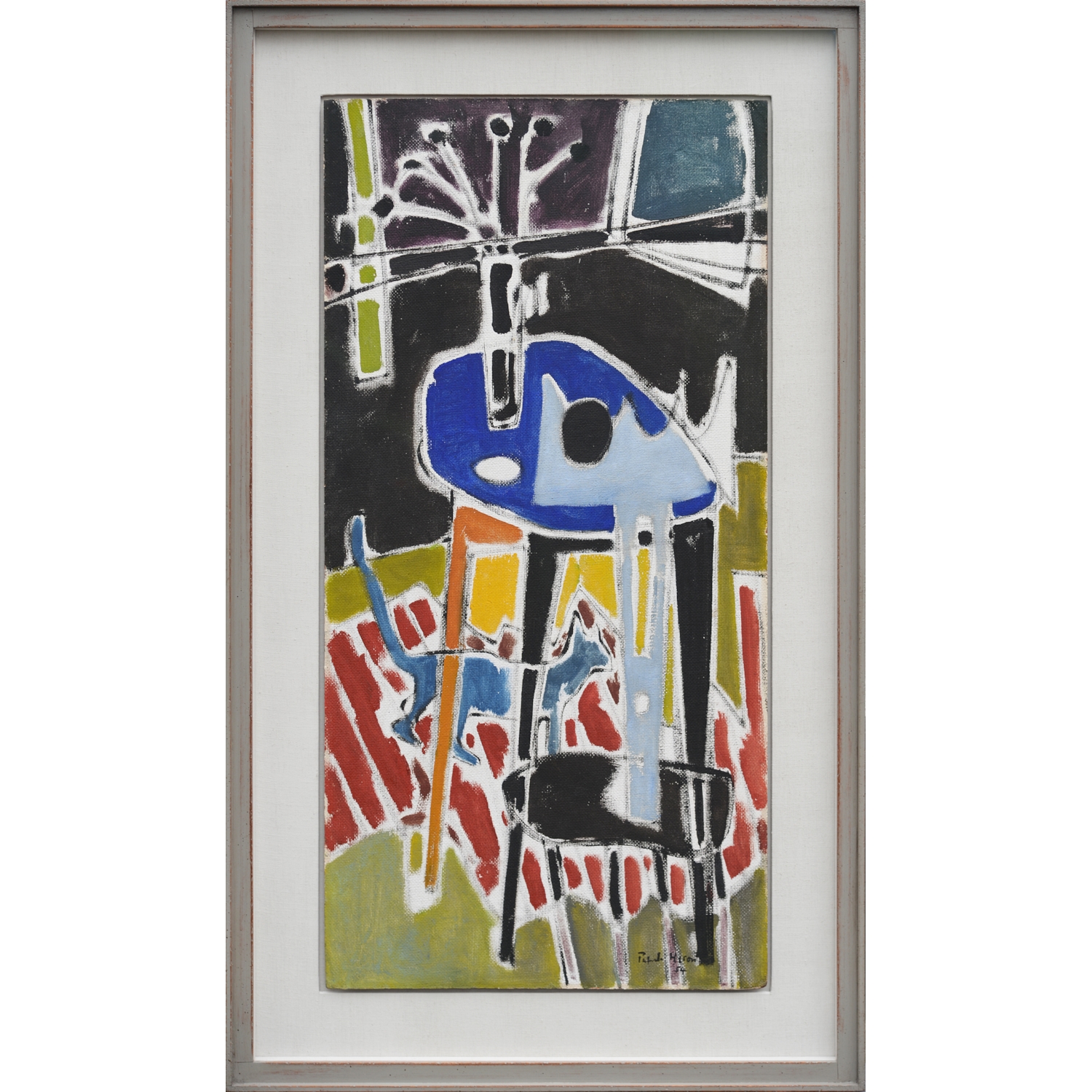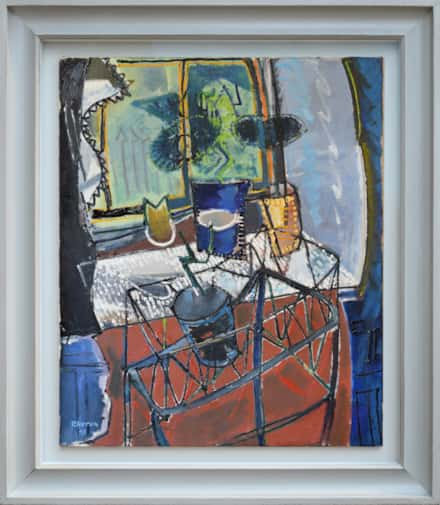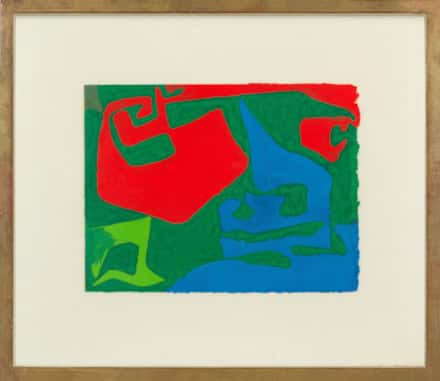Patrick Heron
(1920 - 1999)
Blue Cat Under Table:1954
P1130
Oil on board
Signed and dated 'Patrick Heron/54' (lower right)
Blue Cat Under Table: 1954 comes from a series of innovative still-life paintings made by Patrick Heron, demonstrating his experimentation with form and colour. Incorporating traditional subject matter - a vase presented upon a small circular table in his London home - it was in paintings such as the present work that Heron first championed the idea of ‘Colour in Space’, in which he took the first steps towards the complete abstraction he would later develop in the late 1950s.
Unframed: Height: 36 in (91.4 cm) Width: 18 in (45.7cm)
Framed: Height: 43.5 in (110.5cm) Width: 26 in (66cm) Depth: 3 in (7.6cm)
PROVENANCE
Acquired directly from the artist by the previous owner’s grandfather circa 1954;
Then by descent.
DESCRIPTION
Heron’s experimentation with the still-life genre closely echoes the French Cubist, Georges Braque, in his clever interplay of colour, form and interior and exterior space. Heron visited the French artist in Paris in 1946 and later deemed Braque to be the ‘greatest living master of still life’, who made leaping developments in ‘the most powerful fusion so far made of the abstract and the representational’ (Patrick Heron, ‘Paris Summer, 1940’, The New Statesman and Nation, 16 July 1949). Following the French artist’s approach, Heron explored the ‘transparency’ of objects – for example, how the lines of the windowpanes dissolve into each other. The still-life elements – a table, window and vase – are painted as silhouettes, broad areas of colour that seem to occupy the same plane. Here, characteristic of Heron’s oeuvre at the time, line and colour now orchestrate a perpetual and almost abstract rhythm that runs throughout the painting: the flowers in the vase or the pattern of the rug delineated through simple brush strokes.
As Heron wrote many years later in a letter to the Tate about his table-by-the-window pictures of this period, it was the unique sensation of space that had effectively prompted his exploration of colour as space in these paintings. A year before the present work was painted, Heron curated an exhibition at the Hanover Galley in London, titled Space in Colour. Heron’s work was exhibited along with a further nine British artists who were experimenting with colour as the descriptive emphasis of the painting.
In Blue Cat Under Table: 1954, colour takes the focus over observational accuracy. Referenced in the title, the cat is captured as a simple blue shape but also a shadowy presence under the table. Mel Gooding describes how his still-life paintings ‘have a spontaneous gaiety and an unabashed enjoyment of colour as light, colour released from description, colour shape as a determining dynamic in the formal organisation of the picture ... a lucent clarity is achieved by the direct laying of pure colour onto the primed canvas’ (M. Gooding, Patrick Heron, London, 1999, p. 66).
During the early post-war years, Heron frequently travelled between London and St Ives. After a journey from London, he wrote that ‘I shall never forget the immense sensation of space the first moment we entered that room ... this was the window occurring over and over again in my paintings of that period, whether we were actually in St Ives when I painted them, or at home at Addison Avenue, Holland Park’. Blue Cat Under Table: 1954 offers an exciting glimpse into Heron’s exploration of documenting space through colour and looks forward to his later abstraction where unmodulated colour assumes the entire picture.
EXHIBITION
Huddersfield, Symon Quinn Gallery, Exhibition of Paintings and Drawings by Patrick Heron, February – March 1955, no. 7.
ARTIST'S BIOGRAPHY
Patrick Heron was born in Leeds but moved to Cornwall with his family in 1925, where his father set up a garment factory in Newlyn Harbour. This blossomed into Cresta Silks in Welwyn Garden City, Hertfordshire, where Heron made some remarkably successful designs. In 1937 the artist began a part-time study at The Slade School of Fine Art before working as an agricultural laborer during the war. From 1944 - 5 he was an assistant at Bernard Leach Pottery, St Ives, where he met Barbara Hepworth and Ben Nicholson. In 1945 Heron married his childhood sweetheart Delia Reiss and they lived in Holland park, London; spending their summers at a house on the sea wall in St Ives. After working as an art critic for the New English Weekly for two years, Heron had his first solo show at the Redfern Gallery, London in 1947. In 1953 he started a teaching job at the Central School of Arts and Crafts in London and in 1956 moved to Cornwall, settling at Eagle's Nest in Zennor. Heron inherited Ben Nicholson’s studio overlooking Porthmeor beach at St Ives. Heron was recognised as one of the leading painters of his generation making a significant contribution to the dissemination of modernist ideas of painting through his critical writing and primarily his art. His early work was influenced by that of Georges Braque and Henri Matisse however, in the mid-fifties the artist developed an incredibly unique painterly style that harmoniously fused vivid pigments and intricate patterns. He became devoted to the analyses of natural forms and colours; evident from his abstract works, particularly those made up of horizontal or vertical stripes or with softer-edged shapes, where colour is used to express the pleasure of sight. Heron was awarded the Grand prize at the second John Moores Liverpool Exhibition at the Walker Art Gallery in 1959 and the Silver Medal at São Paulo Biennale VIII in 1965. Exhibitions include the Redfern Gallery, London, the Bertha Schaefer Gallery in New York in 1960, Bonython Art Gallery, Sydney in 1973 and the inaugural exhibition of the Tate St Ives in 1993. In 1998 Heron was given a retrospective at the Tate Gallery, London and today his work can be found in many important public collections such as in the Tate Gallery, St Ives and the National Galleries, Scotland.

YOU MAY ALSO LIKE
Patrick Heron
Blue Cat Under Table:1954





 PRINT
PRINT SHARE
SHARE


